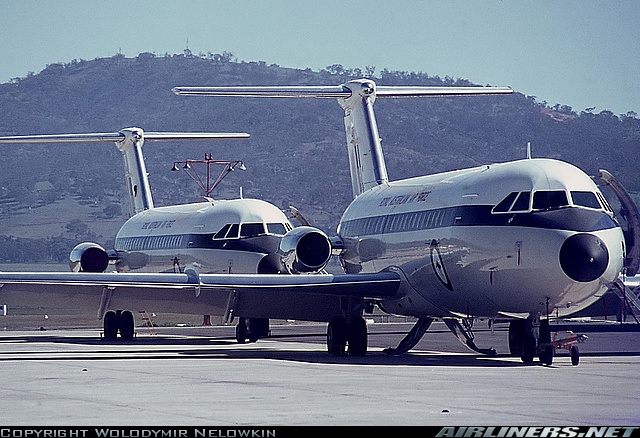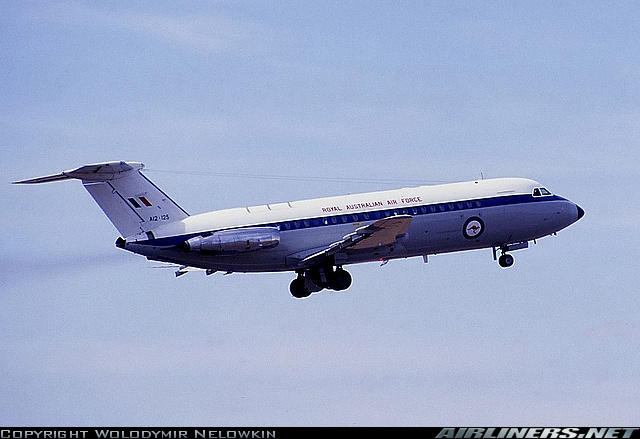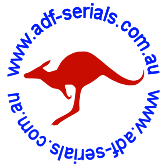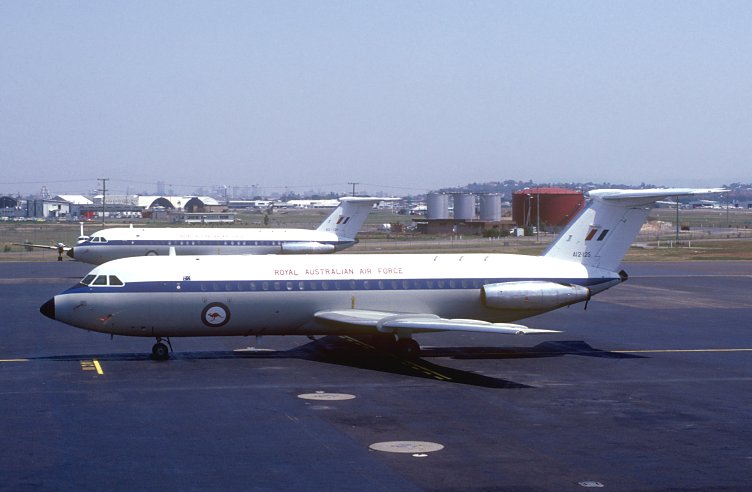| |
The two RAAF BAC 111 aircraft were
initially fitted with two executive cabins of 26 and 30 passenger seats
and were operated in the VIP transport role by 34 Squadron based at
Fairbairn, Canberra. Uniquely, these aircraft had a navigator’s position
in the cockpit and were affectionately known as “Trucks” in RAAF
service. The aircraft were fitted with non-standard Rolls-Royce Spey
Mk.511-14s and a beefed up undercarriage with larger low pressure tyres
for improved airfield performance and for use to destinations with
runways with low bearing strengths. The aircraft were later fitted with
a more luxurious 2 X 2 29 seat cabin to the rear while the forward
section comprised a galley/bar area forward with a four place table crew
area. The main cabin was fitted with four huge pivoting lounge chairs.
Between the main lounge and the rear cabin was another four place table
with electric typewriter connection on one side of the cabin while on
the other side was a three seat divan which folded out into a King Size
bed. Apart from operating to most Australian airfields with runways in
excess of 6,000 ft length and maintaining regular ministerial shuttles
between Canberra, Melbourne and Sydney, the aircraft were flown to
destinations throughout the Far East and Pacific and to India, Iran and
even a one off trip to Glasgow in the UK in Jun73. The aircraft were
also used for special VIP flights such as carrying the Governor General,
Shah of Iran, the President of Burma and the UK Royal Family on various
occasions. Overseas points visited included Apia (Samoa), Bali
(Indonesia), Christmas Island, Cocos Island, Honiara (Solomon Islands),
Jakarta (Indonesia), Kuala Lumpur (Malaysia), Manila and Zamboanga
(Philippines), Norfolk Island, Noumea (New Caledonia), Nuku Alofa
(Tonga), Port Moresby and Rabaul (PNG), Port Vila (Vanuatu), Rarotonga
(Cook Islands), Singapore, Suva and Nadi (Fiji) and Tarawa (Kiribati) in
the immediate vicinity while further afield points visited included
Bangkok (Thailand), Bombay, Calcutta and Delhi (India), Guam, Hong Kong,
Kwajelein (Marshall Islands), Okinawa, Tokyo (Japan), Ponape
(Micronesia), Pyonyang (N.Korea), Seoul (S.Korea), Beijing, Shanghai and
Shenyang (China), Srinigar (Kashmir), Teheran (Iran) while various
points in New Zealand were regular training destinations. The fleet was
retired in early 1990 having flown over 28,000 hours and carried out
over 30,000 landings. Bud Oke has described the ferry flight of A12-124
back to the UK in a fascinating article entitled "The story of the truck
- wabbit one" which can be found in the 'Special Features' section on
Peter Clark's One-Eleven website
www.bac1-11jet.co.uk. Much of the data on this site has been
compiled by myself.
(Introduction written by Richard Church) |
|
| |
| RAAF.Serial |
Type |
Const No. |
Aircraft History |
| A12-124 |
217EA |
124 |
First Flight 03/11/67 as A12-124.
CofA for export issued 08/12/67.
Handed over to RAAF 21/12/67.
Delivered ex UK 12/01/68 arriving Fairbairn 18/01/68 for operations
by 34 Squadron.
Withdrawn from use and handed over to Hawker Pacific 28/02/90.
Sold Burtonwood Developments to whom registered as G-EXPM 05/03/90.
Ferried Canberra-Sydney 17/04/90 and stored.
Registered European Aviation Ltd 10/09/90.
Flew Sydney-Nowra-Sydney 29/08/91.
Permit to fly for an acceptance flight and an Australia-UK ferry
issued 29/08/91 valid until 26/09/91
Departed Sydney 30/08/91 and ferried to the UK by Paddy Cormican,
Mike Birks and Brydon Oke via Alice, Port Hedland, Cocos, Colombo,
Dubai, Cairo and Nice to Southend by where it arrived 01/09/91.
Registration cancelled 06/12/91 on sale to Okada Air Ltd and
initially painted as 5N-TOM.
Repainted as 5N-NRC and delivered ex Southend via Ostend 06/12/91.
Used as a corporate aircraft for charter and company use.
Last recorded hours/landings were 15,732/17,630 respectively on
17/11/93.
Type grounded by the Nigerian CAA 09/05/2002
Stored Benin, Nigeria
Noted still present in a derelict state 08/04/2009.
 |
| A12-125 |
217EA |
125 |
First Flight 10/01/68 as A12-125.
CofA for export issued 31/01/68.
Handed over to RAAF 31/01/68.
Delivered ex UK 08/02/68 for operations by 34 Squadron at Fairbairn.
Withdrawn from use and handed over to Hawker Pacific 30/01/90.
At this stage with a total flight time 12,100 hours and 15,700
landings.
Sold Burtonwood Developments to whom registered as G-KROO 05/03/90.
Permit to fly for an acceptance flight and an Australia-UK ferry
issued 19/04/90 valid until 18/05/90.
Ferried ex Sydney 19/04/90 and ferried to the UK by Paddy Cormican,
Mike Birks and Brydon Oke via Port Hedland, Cocos, Male, Bahrain,
Heraklion and Nice arriving Bournemouth (Hurn) 22/04/90 for storage.
Registered European Aviation Ltd 10/09/90.
Ferried Southend 25/10/91.
Registration cancelled 24/01/92 on sale to Okada Air Ltd having been
previously rolled out as 5N-SDP on 15/12/91.
Delivered ex Southend via Ostend 27/01/92.
Used as a corporate aircraft for charter and company use.
Last recorded hours/landings were 15,145/16,982 respectively on
12/01/93
Type grounded by the Nigerian CAA 09/05/2002
Stored Benin, Nigeria
Noted still present in a derelict state 08/04/2009.
 |
|
|



